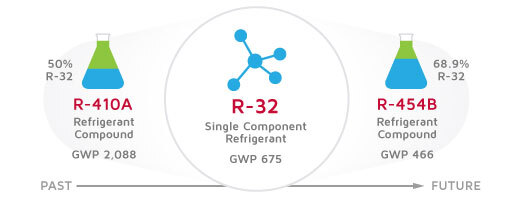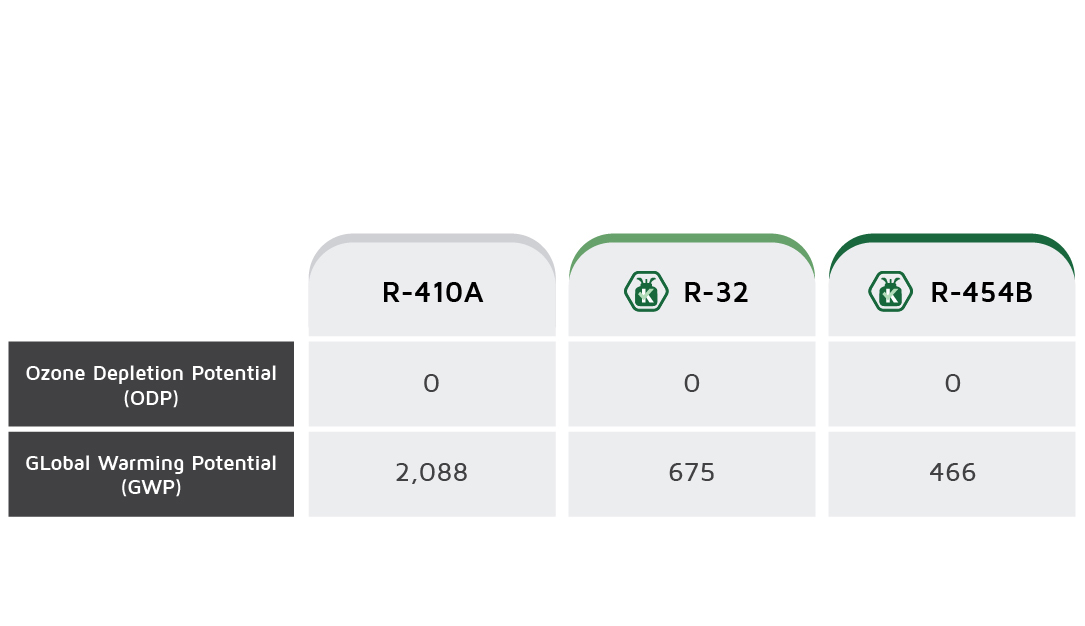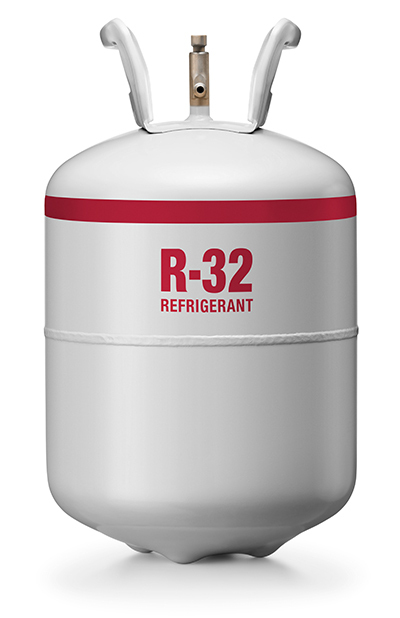Let’s start at the beginning. Refrigerant is the fluid used in HVAC systems to cool warm air. As it circulates within a unit’s coils, it pulls heat from the air allowing the system to reduce or increase the temperature within a space by way of condensation or evaporation – depending on the desired temperature settings.
Chemical refrigerant compounds have been used in commercial and residential HVAC applications since the early 20th century, beginning with a compound called R-22. In the 1970s, scientists discovered that certain types of common refrigerants were harmful to the ozone layer, leading to regulation and the eventual discontinuation of many compounds. Since then, scientists and the Environmental Protection Agency (EPA) have worked to develop and regulate refrigerants that are safe for the ozone and safer for the environment in general. Among these is R-32 – a highly efficient, low-impact compound optimized for ductless HVAC applications such as mini-splits.
To learn more about refrigerant and its history visit our Refrigerant Glossary post.
What is R-32?
R-32, also called HFC-32 Methylene Fluoride is one of several refrigerants developed between the 1990s and early 2000’s to reduce the effects of refrigerant and the HVAC industry on the ozone layer and reduce the production of greenhouse gasses. Though R-32 wasn’t put into service in its pure form until 2012, it has been around much longer. Combined with the less flammable R-125, R-32 makes up one-half of R-410A – an HVAC industry standard since the 1990’s.
A refrigerant compound’s environmental impact is determined by its Global Warming Potential (GWP). GWP is a system used to rate a refrigerant’s impact on climate change as compared to CO2, the primary greenhouse gas.
In pure form, R-32 has zero Ozone Depletion Potential (ODP) and holds one of the lowest GWP rating among commonly used refrigerants at 675. That’s about one-third the impact R-410A, the refrigerant it typically replaces, with a GWP of 2,090.

*It should be noted that R-32 makes up 68.9% of R-454B, Lennox’ primary 2025 Compliant Refrigerant for whole home systems – helping it achieve an even lower GWP rating of 466.
Despite these exceptional performance stats, certain characteristics of R-32 made it a difficult refrigerant to handle and install compared to other common compounds. It wasn’t until 2012, when equipment technology advanced to meet the safety and installation requirements of R-32, that it became a widely used industry option.
Why the Switch to R-32?
Mandates stemming from the 2020 American Innovation and Manufacturing (AIM) Act enabled the EPA to regulate refrigerants and their effects on the planet. A number of new compounds, R-32 among them, have been developed to contribute to the Act’s ultimate goal of an 80% reduction in cumulative GWP across the HVAC industry by 2034.
As we discussed, R-32’s ODP and GWP ratings make it a more favorable alternative to many older and less environmentally friendly compounds. R-32 has:
A GWP Rating of 675
R-32’s GWP rating is 67% lower than previous standard compounds and meets the EPA’s 2025 requirement of GWP 700 or lower.
Zero ODP and Low Toxicity
R-32 poses no danger to the ozone layer.
Along with great environmental performance, there are other aspects of R-32 that make it a great step toward 2025 compliance.
Cost Impact
Because R-32 isn’t a mixed refrigerant compound like R-410A or R-454B, it’s simpler and less labor intensive to produce. Because of this simplicity, R-32 generally costs less than R-410A, making a more cost-effective option.
Safety
Whereas R-410A holds a safety classification of A1, meaning it is non-toxic and non-flammable, R-32, along with R-454B are classified as A2L. A2L indicates non-toxic and lower flammability. Though R-32 is considered flammable, A2L refrigerants are still safe and relatively easy to work with using standard precautions. The non-toxic portion of the A2L classification means that R-32 is harmless to breathe and poses no inhalation or exposure danger in the event of a leak.
What Does the R-32 Transition Mean for You?
Given its compatibility across R-410A and R-22 systems, converting your mini-split to R-32 is far less involved – or impactful – than that of a whole home system to R-454B. Minor upgrades or modifications may be required to ensure compatibility and performance with your specific model, but generally the process should be reasonably quick and easy.
Given the simplicity of the transition and the environmental and efficiency benefits you’ll gain, we do recommend reaching out to your local Lennox dealer or technician today to learn more about the benefits of switching to R-32.
However, if you do decide to wait, the AIM Act timeline is designed to allow for a gradual refrigerant transition across all system types between now and 2036. Service and maintenance will still be available for older R-410A systems with dealers and technicians providing R-410A services from existing refrigerant inventory until you decide to make the switch.

Mini-split systems manufactured after January 1, 2025 will be built with R-32 refrigerant in order to meet 2025 EPA requirements.
Reach out to a local Lennox dealer or technician today to learn more about the benefits of switching to R-32 in your ductless air conditioner or heat pump system. The transition will re duce your carbon footprint, improve the efficiency of your system, and help contribute to an 80% reduction in GWP by 2034.
duce your carbon footprint, improve the efficiency of your system, and help contribute to an 80% reduction in GWP by 2034.
Our new lineup of R-32 mini-splits and R-454B compatible whole home systems will be available in the second half of 2024. Find a Lennox dealer near you to learn more about what your transition to a greener HVAC system could look like.



